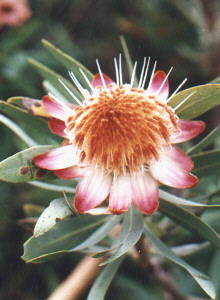
Home
Mission
Overview of Project
Project Staff
Sponsors
Achievements
Checking, Illustrations
Upcoming Activities
Id and Species Lists
Protea Information
Protea Gallery
Growing Proteas
Interim Dist. Maps
Publications
Afrikaanse Inligting
![]()
Strydpoort Mountains – 2-3 Sept. 2000
Atlassers Joop Loeve, Brian Elms and I joined Robin & Patricia Baragwanath, Pieter Winter and Clare Bell of Heanertsburg in the Northern Province to atlas in the Strydpoort Mountains close to Haenertsburg. This linear mountain range stretches for about 150 km westwards from the Wolkberg Mountains near Tzaneen, almost as far as Potgietersrus.
The area has a complex geology, including granite, quartzite and dolomite, which has been mined in the past for gold and asbestos. Due to the poor availability of water and remoteness of the area, most of the farms in the area are now abandoned – good news for the proteas and other flora. Pieter pointed out several dolomite endemics and undescribed species in this area, including a small prostrate Euclea and a Euphorbia.
 We atlassed Ribbokkop, the highest peak in the area at 2060 m, on the
Saturday. Protea caffra was very common on the
lower dolomite slopes, with small clumps of Pr roupelliae
from about 1700 m. Higher up, where the hard quartzites make up the summits of the
mountains, the steep slopes are dominated by Pr rubropilosa Transvaal
Sugarbush and Pr roupelliae. Pr rubropilosa,
with its beautiful velvet-brown bracts, was just starting to come into flower. Here,
against the steep north-facing slopes, we also found extensive populations of dwarfed Pr
caffra that reached a height of 1 m at most.
We atlassed Ribbokkop, the highest peak in the area at 2060 m, on the
Saturday. Protea caffra was very common on the
lower dolomite slopes, with small clumps of Pr roupelliae
from about 1700 m. Higher up, where the hard quartzites make up the summits of the
mountains, the steep slopes are dominated by Pr rubropilosa Transvaal
Sugarbush and Pr roupelliae. Pr rubropilosa,
with its beautiful velvet-brown bracts, was just starting to come into flower. Here,
against the steep north-facing slopes, we also found extensive populations of dwarfed Pr
caffra that reached a height of 1 m at most.
We searched in vain at the higher altitudes for Pr simplex, which I had thought I had found in the Highlands Mountains east of Potgietersrus on the last weekend of July. I reasoned that the habitats were similar and if they had occurred in the Highlands Mountains, they should definitely occur closer to their known range in the Strydpoort Mountains. However, the more I searched in vain, the more convinced I became that I had misidentified juvenile Pr caffra plants as Pr simplex four weeks previously. What was surprising is that we found no Pr welwitschii, which was very common in the Highlands Mountains in similar habitat.
On the way down the mountain, I twisted my ankle and limped my way down to our campsite with an ankle of ever-increasing size. On Sunday, not being able to hike further, Patricia took me to the farm of a local farmer, John Lategan, who drove us up to the highest peaks on his farm to atlas further populations of Pr rubropilosa and Pr roupelliae. We also drove up to the "Iron Crown", a 2200 m peak with a panoramic view, where we did find Pr simplex. The rest of the party took a steep hike up the northernmost ridge of the Strydpoort Mountains, where they found Fa saligna against the south-facing slopes and more Pr rubropilosa and Pr roupelliae at the summit.
This remote and unspoilt mountain range definitely justifies a return visit, to confirm how far west along the range Pr rubropilosa and Pr roupelliae can be found.
Reuben Heydenrych, Pretoria
Back PAN 49